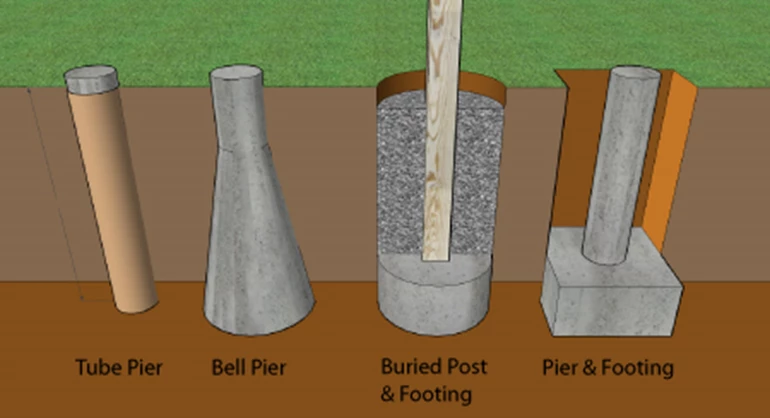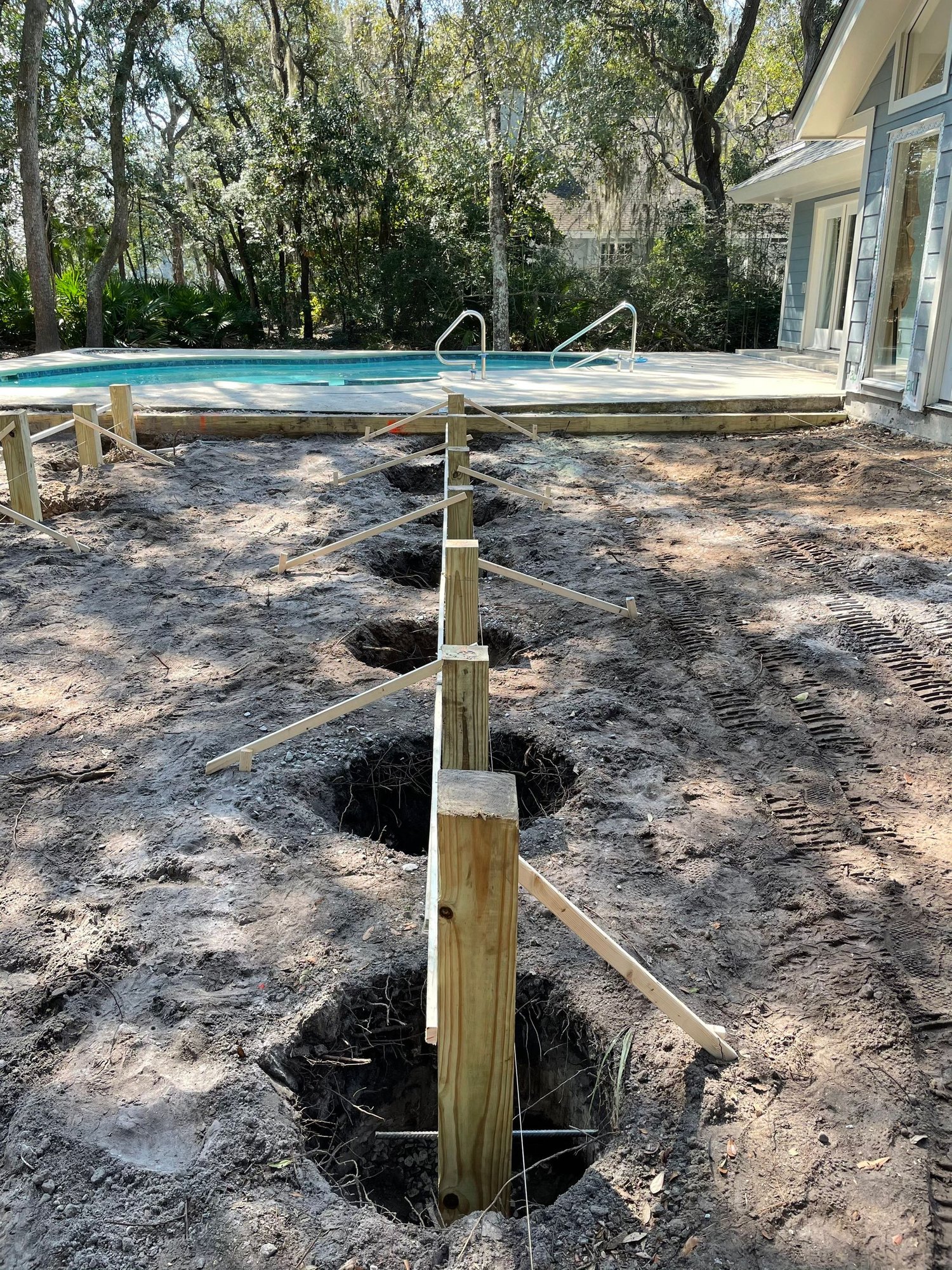Expert Tips for Installing Deck Footings to Assistance Your Outdoor Space
When it comes to developing a deck, one of the most vital elements to consider is the installation of proper footings. These grounds are the foundation upon which your exterior space will relax, giving stability and assistance for years to come. What specifically does it take to mount deck footings correctly?
Value of Appropriate Deck Footings
Appropriate deck grounds are essential for making certain the stability and longevity of your outside space. When building a deck, it is essential to focus on the structure on which it will certainly rest. Deck footings provide the needed support for the whole framework and assistance distribute the weight evenly - Deck Footings. Without solid and correctly installed grounds, your deck might come to be unsteady, causing safety and security hazards and pricey fixings.

In addition to stability, proper deck grounds likewise add to the longevity of your outdoor area (Deck Footings). Footings that are made and built to stand up to the elements and soil problems in your area will certainly assist stop the deck from changing or working out over time. By ensuring the grounds are appropriately sized and mounted, you can decrease the danger of damages to the deck structure, expanding its life expectancy and reducing the requirement for pricey repair services or replacements

Choosing the Right Kind Of Grounds
When picking the ideal sort of grounds for your deck, it is very important to think about elements such as soil conditions, neighborhood building ordinance, and the total layout of your exterior room. The kind of footing you choose will certainly play an important duty in guaranteeing the security and longevity of your deck.
One usual kind of ground is the concrete ground. Concrete grounds are appropriate for a lot of dirt problems and supply exceptional assistance for decks.
In some instances, you might need to use specialized footings, such as pile grounds or deep structures, if you are constructing a large or multi-level deck. These grounds are made to disperse the weight of the deck over a bigger area, guaranteeing stability and avoiding working out or sinking.
Before picking a type of footing, it is vital to seek advice from regional building codes and guidelines to make sure conformity. Additionally, consider the layout and planned use of your exterior area. Elements such as the size, form, and load-bearing needs of your deck will certainly affect the sort of footing that is most ideal.
Preparing the Ground for Footing Setup
To effectively prepare the ground for footing installment, it is crucial to evaluate the dirt problems and take essential actions to guarantee security and toughness of the deck. The first action is to dig deep into the location where the footings will certainly be installed. The deepness of the excavation will rely on the frost line in your region and the particular needs of the deck style. It is vital to remove any kind of greenery, rocks, or particles from the excavation to guarantee a strong foundation.
When the location has actually been excavated, the next step is to small the dirt. This can be done making use of a plate compactor or by utilizing a hand meddle. Condensing the soil assists to remove any gaps or air pockets, which can cause settling and instability in time.
After condensing the dirt, it is essential to lay a layer of crushed rock or smashed rock at the end of the excavation. This will give drainage and help to stop water from merging around the grounds, which can lead to erosion and instability.
Step-by-Step Overview to Setting Up Deck Footings
After effectively preparing the ground for footing installation, the next action is to start the procedure of mounting look at this now deck grounds. This detailed overview will provide you with a clear understanding of how to set up deck footings for your outside room.
Establish the location: Start by click for info marking the settings of the deck footings utilizing risks and string. Make sure that the places align with the style and design of your deck.
Dig the openings: Utilize a message hole miner or an auger to dig the openings for the footings. The depth and size of the openings should be in conformity with neighborhood building regulations and the details needs of your deck design.
Degree the openings: Utilize a level to guarantee that the openings are dug to the appropriate depth and are degree with each various other. (Deck Footings)
Include crushed rock: Place a layer of gravel at the end of each hole to boost drainage and avoid the wood from deteriorating.
Put the grounds: Put the footings right into the holes, seeing to it they are degree and plumb. Make use of a degree and a gauging tape to guarantee accuracy.
Safeguard the grounds: Pour concrete into the openings around the footings, filling them to the top. Use a post degree to guarantee the footings continue to be degree as the concrete sets.
Allow time for healing: Let the concrete treatment according to the supplier's guidelines before waging the deck building and construction.
Typical Mistakes to Stay Clear Of Throughout Footing Setup
One important element to think about throughout the setup of deck grounds is preventing common errors that can jeopardize the stability and long life of your outdoor room. While deck footings may feel like a straightforward and simple component of the building procedure, neglecting particular elements can bring more tips here about expensive repair work and possible safety dangers down the line.

Furthermore, neglecting to set up appropriate water drainage steps can create water to build up around the grounds, resulting in rot, degeneration, and the eventual weakening of the deck's structure. Additionally, making use of the wrong kind of footing material or stopping working to properly protect the footings can endanger their structural integrity.
To stay clear of these blunders, it is crucial to seek advice from with a specialist or adhere to sector guidelines to make certain proper footing setup. By doing so, you can make sure the security and long life of your exterior space, offering a delightful and secure environment for years to come.
Conclusion
In verdict, mounting correct deck footings is essential for the stability and longevity of your outside area. By selecting the ideal kind of grounds and adequately preparing the ground, you can make sure a solid foundation for your deck. Complying with a step-by-step guide and preventing usual blunders throughout footing setup will better enhance the resilience and safety of your deck.
Proper deck grounds are necessary for guaranteeing the stability and long life of your exterior area. The footings offer as a link in between the ground and the deck, enabling the weight of the deck and its residents to be dispersed equally right into the dirt.One typical kind of ground is the concrete footing. Place the footings: Place the footings right into the openings, making certain they are level and plumb. Secure the grounds: Pour concrete into the holes around the grounds, filling them to the top.